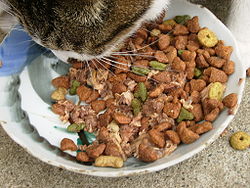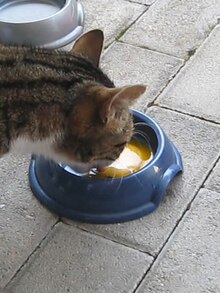cat food
As cat food industrially produced is mostly pet food for cats called. Depending on the composition, a distinction is made between complete feed and supplementary feed and, depending on the consistency, between dry and wet feed.
General
As “pure” or “true” carnivores and because of their high protein requirement , cats get a large part of their nutritional needs from sources of animal origin. In this context, your metabolism has some peculiarities. There is an inability to convert the vegetable precursor of vitamin A ( β-carotene ) into functional vitamin A. The aminosulfonic acid taurine and the amino acids methionine and arginine are essential for the cat organism . There is also a high need for nicotinic acid . Female cats and neutered males are unable to convert linoleic acid to arachidonic acid. They do not need any carbohydrates to maintain a normal blood sugar level ; instead, glucose can be formed from the feed through the deamination of special amino acids.
According to their natural eating behavior (catching small prey) cats eat 10 to 20 times a day if they are constantly offered food. The daily energy requirement of a house cat weighing just under four kilograms is around 1,250 kJ (= 300 kcal ) of convertible energy. Some cats react to major changes in both the ration offered and the type of food by refusing to eat for several days, which, especially in overweight animals, can lead to a fat mobilization syndrome with life-threatening metabolic disorders due to abnormal liver values and even liver failure .
Industrially produced cat food is offered as dry or wet food ; they differ in water content. This is around 10–14% for dry feed and around 75–84% for wet feed. As a result, dry feed has a much higher energy density and must therefore be fed in much smaller rations. When feeding with dry food, especially indoor cats, additional water must be given. Milk is unsuitable - adult cats can only tolerate lactose-reduced milk anyway, as they no longer produce lactase .
While dry food is mostly packed in plastic bags or boxes, wet food is offered in cans, aluminum trays or plastic bags (pouches), e.g. B. one packaging unit per serving.
Feed compositions
carbohydrates
Cats do not depend on the intake of metabolizable carbohydrates and, as carnivores, have a shorter digestive system that is primarily, but not exclusively, geared towards digesting meat.
In addition, there are indigestible carbohydrates in the feed, which are important as fiber and support the intestinal motor skills. The main source of digestible carbohydrates - they ferment and help protect the intestinal walls - are components of corn , rice , wheat , oats , barley , carrots , molasses , peas and potatoes .
The indigestible fibers present in the feed are obtained from beet pulp , rice bran , apple and tomato pomace , peanut shells , citrus pulp, oat and wheat bran or cellulose .
Fats
In cats, the required proportion of essential fatty acids must be observed. About 5 to 7 percent of the energy in the feed should be covered by linoleic acid . Arachidonic acid should account for 0.04 to 0.1 percent of the energy . Chicken and poultry fats are most common in cat food. Vegetable sources of fat are corn, safflower and soybean oils. The fat content of cat food is usually between 5 and 15 percent. Due to the high energy density of fats, this food component makes up about 40 percent of the physiological calorific value of the feed.
Proteins
Cats require significantly more protein than other domesticated house mammals. Experiments have shown that young cats can only grow satisfactorily from a protein content of 30 percent of the dry matter of the food. For adult animals, this value is around 26 percent. The proteins incorporated into the feed can be of both animal and vegetable origin, the animal proteins being classified as higher quality. Common sources of animal protein are beef , chicken , poultry by-products, poultry meal , dried eggs , fish , fish meal , meat meal , bone meal and other by-products.
"Animal by-products" are used in animal carcass recycling and in accordance with EU Regulation 1069/2009 describes whole animal bodies or parts of animals or products of animal origin or other products obtained from animals that are not intended for human consumption, including egg cells, embryos and semen . For the purpose of recycling as animal feed, they must correspond to category 3 .
The following vegetable protein sources are used: corn gluten , soy products , green alfalfa meal , dried brewer's yeast , flaxseed meal and wheat germ .
requirement
Arginine
The amino acid arginine is essential for cats for life because the organism cannot synthesize it to a sufficient extent. In addition to its importance for the formation of new proteins , it is an indispensable part of the urea cycle , which is a particularly important metabolic pathway in cats due to the large amount of ammonia that occurs with the high protein utilization . Even to a single arginine-free meal, the cat organism reacts with severe hyperammonaemia , which can lead to symptoms such as vomiting , ataxia , hyperesthesia and tetanic convulsions, up to coma and death. The arginine requirement of a young cat is 1.1 percent of the dry matter of the food.
Taurine
Cats are only able to synthesize small amounts of taurine . This low de novo synthesis is also known for humans , some monkey species , rabbits and guinea pigs . The reason that these species are not deficient is due to their comparatively low demand. Due to the fact that their bile salts are only formed with taurine, cats need a much higher proportion of this aminosulfonic acid in order to compensate for the loss with the faeces . Deficiency states are essentially expressed in two clinical syndromes. Besides the possibility of formation of a dilated cardiomyopathy (DCM or suffering from DCM) that is the central retinal degeneration of the cat (feline central retinal degeneration, FCRD). The recommended daily dose of taurine is 200… 500 mg. 1000… 2000 mg / kg dry matter is added.
Methionine
The amino acid methionine cannot be synthesized by cats and is therefore essential for building body proteins and for phospholipid synthesis in the course of fat digestion. The requirement is around 1.6 g per 1000 kcal of digestible energy.
Nicotinic acid
There is a high need for nicotinic acid , since this vitamin cannot otherwise be sufficiently formed due to a high need for tryptophan for the synthesis of picolinic acid . In practice, however, there is no deficiency here, since animal tissues contain sufficient quantities.
Other ingredients
Like any mammal, cats need vitamins , bulk elements and trace elements to maintain good health . According to u. a. Calcium, vitamin A, vitamin D, vitamin E, vitamins B1-6, B9, B11, B12, iron, zinc, manganese, copper, iodine as well as biotin and phosphorus.
Preservatives are often used in industrially produced feed .
Caramelized sugar serves as a visual presentation of the food - which is often only important for the cat owner - and as a plasticizer.
Alternative feed or forms of nutrition
BARF
The term BARF refers to feeding with raw feed, consisting predominantly of meat and, to a lesser extent, vegetable components and possibly supplements. BARF stands as an acronym for Biologically appropriate raw food , which was translated in German with the backronym "Biological Appropriate Raw Food".
Vegetarian or vegan food
Since the end of the 20th century there have been cases in which owners consciously fed their cats vegetarian or vegan , while commercially produced vegetarian or vegan food only came onto the market towards the beginning of the 21st century. The Stiftung Warentest tested in 2008 for the first time a vegetarian product that was found to be food for "totally inappropriate".
A purely vegetarian diet for cats is strictly rejected by veterinarians and the German Animal Welfare Association because of the risk of malnutrition. Scientific studies on vegetarian or vegan cat nutrition are hardly available to date. A study from 1999 came to the result that a vegetarian diet with supplements could cover needs, but in practice none of the eight cats examined was actually fed as needed. However, a diet with strictly balanced and adhered to supplementation is considered possible. In a US study up to 2006, the blood of cats was examined for the concentration of taurine and vitamin B12, which were fed a vegetarian diet and mostly supplemented with other nutrients by the owners. In any case, with regard to these nutrients, values in the reference range were predominantly found. The National Research Council (United States) also warns of insufficient supply, but considers a strict vegetarian diet to be possible with adequate supplementation.
literature
- Jürgen Zentek: Nutrition for healthy and sick cats . In: Hans Lutz, Barbara Kohn, Franck Forterre (ed.): Diseases of the cat . 5th revised edition. Enke Verlag, Stuttgart 2014, ISBN 3-8304-1242-8 .
- Natalie Dillitzer: Veterinary nutritional advice: dietetics and feeding of dogs, cats, reptiles, guinea pigs and rabbits. 2nd Edition. Urban & Fischer Verlag / Elsevier, Munich 2012, ISBN 3-437-58311-5
- Nutrient Requirements of Cats. National Academies Press. Pg 30. ISBN 978-0-309-03682-5
- Hans-Ulrich Grimm : Cats would buy mice. Schwarzbuch Tierfutter , Heyne, Munich 2009 (first edition: Deuticke Verlag, Vienna, 2007, ISBN 978-3-552-06049-4 ), ISBN 978-3-453-60097-3
- Horse, donkey and eland . In: The Gazebo . Issue 23, 1863, pp. 367 ( full text [ Wikisource ] - report on cat food).
Web links
- Stiftung Warentest : Cat food: Readers ask, test.de answers. test.de , February 27, 2014; accessed on March 2, 2015
Individual evidence
- ↑ Michael S. Hand: Clinical dietetics for small animals . Schlütersche, 2002, ISBN 978-3-87706-893-9 , p. 379–.
- ↑ Composition & Ingredients of Cat Food, Section Water Content , accessed on June 8, 2020
- ↑ Michael S. Hand: Clinical dietetics for small animals . Schlütersche, 2002, ISBN 978-3-87706-893-9 , p. 385.
- ↑ einfachierisch.de
- ↑ katzen-links.de
- ↑ katzen-fieber.de
- ↑ drquinten.de (PDF) page 6
- ↑ a b Radka Engelhard: Field study on the vegetarian diet of dogs and cats , Munich, Univ., Diss., 1999 Abstract ( Memento from December 29, 2015 in the Internet Archive ) at www.vetmed.uni-muenchen.de
- ↑ Cat food: Less is more . Stiftung Warentest , August 27, 2008
- ↑ The German Animal Welfare Association on a vegetarian diet for cats ( Memento from March 30, 2016 in the Internet Archive ), accessed on March 30, 2016.
- ↑ a b zeo2 3/2014 (available at taz.de): Vegan food: an unauthorized animal experiment .
- ↑ Michael S. Hand: Clinical dietetics for small animals . Schlütersche, 2002, ISBN 978-3-87706-893-9 , p. 210.
- ↑ Jens Lubbadeh: Animal nutrition: "I refuse to feed cats vegan" , interview with veterinarian Ellen Kienzle, Der Spiegel , May 2, 2014
- ↑ LA Wakefield, FS Shofer, KE Michel: Evaluation of cats fed vegetarian diets and attitudes of their caregivers . In: Journal of the American Veterinary Medical Association . 229, No. 1, 2006, pp. 70-3. doi : 10.2460 / javma.229.1.70 .
- ^ Nutrient Requirements of Cats . National Academies, 1986, pp. 30ff., NAP: 14564.
- ↑ Strict vegetarian diets are not Appropriate for cats unless supplemented with nutrients essential for cats did are not found in plants (dt .: Strict vegetarian diets are not suitable for cats, unless essential nutrients are added, need the cats but not in Plants are included. ), In: National Research Council: Your Cat'S Nutritional Needs; A Science-Based Guide For Pet Owners . (PDF) 2006




